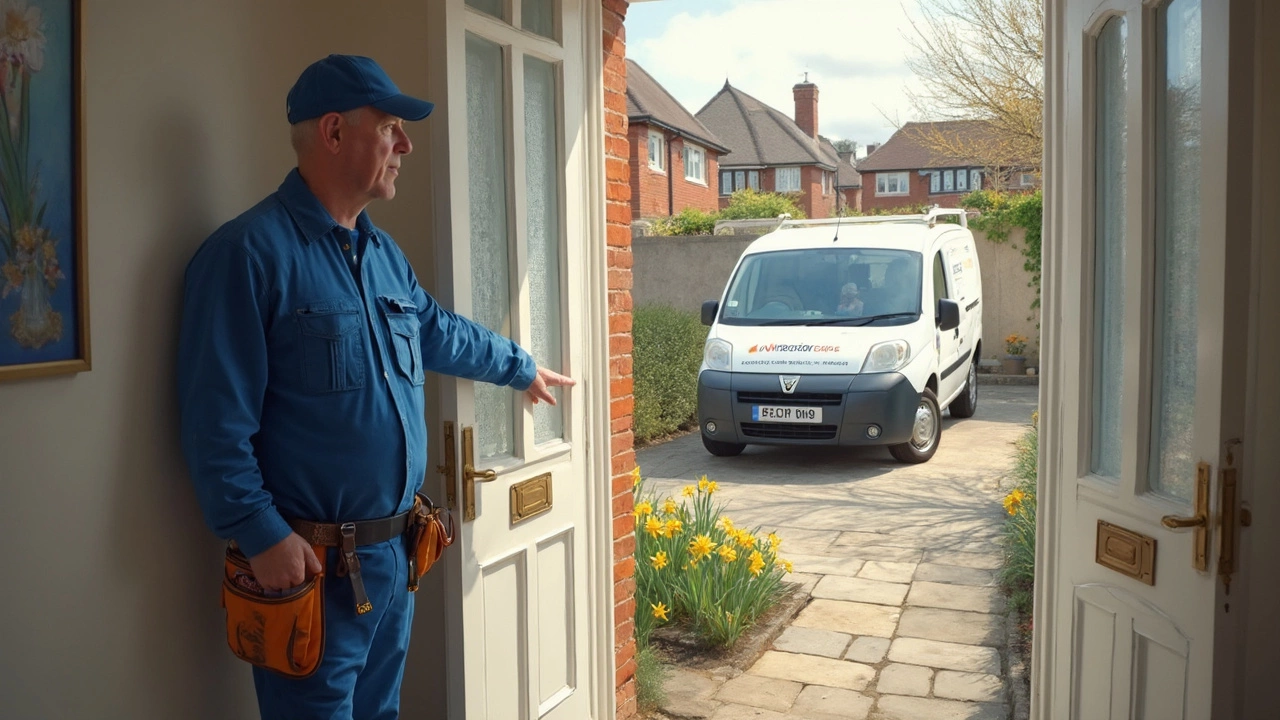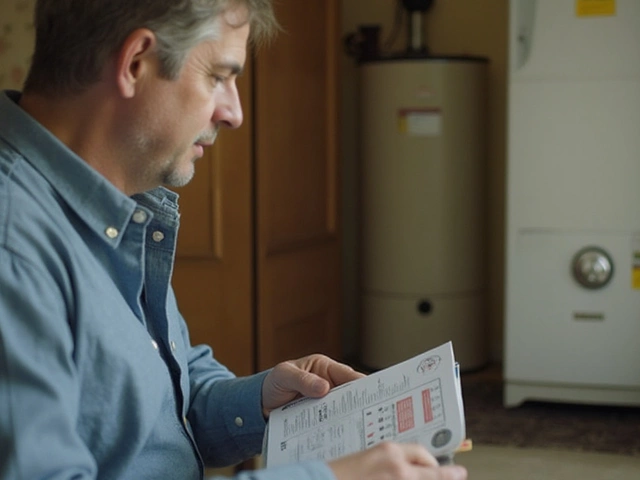If your bathroom extractor fan starts making weird noises, blows out no air, or just gives up completely, it’s honestly more common than you’d think. Loads of people have no clue who actually fixes these things. Is it an electrician, a handyman, or do you just buy a new fan? Before you start yanking it off the ceiling or Googling random repair guys, let’s tackle what really goes into getting these fans fixed.
Most extractor fans conk out because of blocked vents, dust build-up, old wiring, or worn-out motors. Sometimes it’s just a loose connection. Other times, it’s pure age—if your house still has the fan that came with the house twenty years ago, that thing’s had a good run.
- Why Bathroom Extractor Fans Break Down
- DIY Fixes vs. Calling a Professional
- Who Repairs Bathroom Extractor Fans?
- How to Choose the Right Repair Person
- What to Expect During the Repair
Why Bathroom Extractor Fans Break Down
Bathroom extractor fans aren’t built to last forever, and most issues boil down to a handful of common problems. The biggest reason these fans give up is dust and gunk. Over time, steam, lint, and even hair get sucked into the fan, leading to clogs and extra strain on the motor. Blocked vents can slow your fan way down or stop it from moving air at all.
Old or dodgy wiring comes in next. Maybe your house is a bit older, or maybe your last fan was installed on the cheap. Electrical connections wear out, and sometimes wires corrode or come loose, making the fan either flicker or refuse to start. Moisture is a huge factor—bathrooms basically live in a cloud of steam, which isn’t great for any electrical gear, even stuff made for wet spaces.
Bearings and fan motors themselves are the big-ticket breakdowns. Bearings get noisy when they dry out, and eventually the motor can just wear down and stop spinning. If you’ve got that classic whining sound, it’s probably bearings. Grinding or silence might mean the motor is burned out.
Here are the troublemakers in a nutshell:
- Dust and debris choking up the fan blades or vents
- Old or faulty wiring causing electrical issues
- Broken or worn-out motors and bearings
- Moisture leading to rust, short circuits, or mold
- Poor initial installation—loose mountings or gaps let air escape
Surprisingly, the typical bathroom extractor fan only lasts about 7-10 years before something gives out. Cheaper models can quit even sooner if you don’t keep them clean. If you want to know what fails most, electricians who do fan repair jobs report that about 60% of call-outs are either clogs or worn motors (see breakdown below):
| Common Problem | Percent of Repairs |
|---|---|
| Dust/Debris Blockage | 35% |
| Worn Motor/Bearings | 25% |
| Faulty Wiring | 20% |
| Rust/Moisture Damage | 15% |
| Other Installation Issues | 5% |
Most of these can be avoided or delayed with a bit of basic maintenance: clean the fan regularly and check it works after steamy showers. If the fan was cheap or really old, though, it might just be time for a new one or a proper repair job.
DIY Fixes vs. Calling a Professional
Before rushing to hire someone, there are a few basic checks you can handle on your own. The good news? Some bathroom extractor fan problems are crazy simple—think clogged grilles or a flipped fuse. If the fan’s not working at all, first check the power supply. Seriously, sometimes it’s just a tripped circuit breaker or a switch that’s been knocked off.
Here’s what you can usually try safely, even if you’re not a DIY genius:
- Turn off the power at the breaker—always do this before touching anything.
- Remove the fan cover and clean out dust, lint, or gunk with a vacuum or small brush.
- Check for obvious blockages in the vent leading outside.
- If the fan is humming but doesn’t spin, give the blades a gentle nudge (sometimes stuck dust is the culprit).
- Make sure the wall switch is working and hasn’t worn out. Swap for a new one if it feels loose.
You’d be surprised how often fans just need a proper cleaning to work again—especially in homes with pets or if you’ve done a bunch of dusty remodeling lately. According to a survey by Which? in 2023, around 40% of reported extractor fan issues were solved with a simple clean-out and reset.
But when should you park the DIY tools and call someone? Here’s when you should pick up the phone for a fan repair specialist or electrician:
- There’s a burning smell or signs of melted wiring—this is a potential fire hazard.
- The fan motor makes grinding noises or runs extremely hot.
- You’ve tried the basics but the fan still won’t turn on.
- There’s visible moisture around the housing or signs of electrical damage.
The point is, don’t push it if you hit anything electrical or the fan seems dead as a doornail. Licensed pros have the tools and training to safely repair or replace faulty extractor fan units. Plus, from a safety angle, tampering with old wiring isn’t worth the risk—especially in humid, bathroom conditions where electrical faults can get ugly fast.

Who Repairs Bathroom Extractor Fans?
This question trips up more people than you’d expect. When a bathroom extractor fan stops working, the first instinct might be to call a random handyman, but the job actually lands between a few trades.
Electricians are usually your safest bet. These fans are wired straight into your house’s electrical system, so messing with them is best left to someone who knows what they’re doing. Electricians not only deal with the wiring, but they’re also trained to spot bigger issues, like a power supply problem or faulty switch.
If the problem is more about old blades, cleaning, or a clogged vent, a skilled handyman can sometimes handle it—especially if all you need is a clean-out or a simple fan swap. Just make sure whoever you hire is comfortable working safely with electrical fixtures. Some handymen have basic electrical tickets, while others avoid wiring entirely.
For bathrooms in apartments or buildings with complex ventilation systems, you might need a specialist – someone who does extractor fan repair or ventilation work. These folks usually handle big blockages, duct cleaning, or replacement fans in larger buildings. If your fan routes through ducts up into the attic or out the roof, this is worth considering.
- Electrician: Go-to for all wiring or electrical faults, and fan installs.
- Handyman: Good for basic swaps, cleaning, or minor fixes that don’t touch wiring.
- Ventilation Specialist: Needed for complicated ductwork, bad smells, persistent damp, or systems in larger developments.
Don’t overlook that most electricians and handymen give free quotes. If you mention the make and model (if you know it), the process goes even smoother. And if your fan’s still under warranty, the maker might cover repairs or even replacements. No need to shell out money if you don’t have to.
Here’s a quick table with who does what, just to make it clearer:
| Type | Handles | Average Cost |
|---|---|---|
| Electrician | Wiring, replacement, new installations | $80–$200 per job |
| Handyman | Cleaning, basic swaps (no wiring) | $50–$120 per job |
| Specialist | Duct cleaning, complex setups | $120–$300 per job |
Stick to the right pro for your problem—no use paying for wiring help if you just need the grill vacuumed out.
How to Choose the Right Repair Person
So your bathroom extractor fan won’t work, and you’ve realized it’s not as simple as swapping out a lightbulb. When it comes to finding the right person to fix it, you want someone who actually knows their stuff. This isn’t just a job for any handyman—lots of issues tie back to electrical work, and the wrong fix could leave you with even bigger problems.
First off, most people end up choosing between a registered electrician and a qualified ventilation specialist. Electricians can handle wiring, check for safe connections, and swap out broken parts. But if your fan repair problem includes airflow issues or bad venting, a ventilation pro might spot problems a regular sparkie could miss.
If you’re keen on getting this sorted fast, stick to these steps:
- Check qualifications: Ask if they’re certified. In the UK, you’ll want a Part P registered electrician; in the US and elsewhere, check for current licensing. Proper paperwork means they know code and safety rules.
- Look for extractor fan experience: Not every electrician or handyman is familiar with extractor fan specialist jobs. Ask if they’ve fixed bathroom fans before, and if they can supply references or photos of recent work.
- Read reviews: Google them, check local forums, or browse platforms like Trustpilot and Nextdoor. You’ll usually spot red flags or stand-out positives pretty quick.
- Compare prices: Don’t just grab the first quote. Typical call-out fees range from £50–£100 in the UK or $75 to $150 in the US, depending on the job. Always ask for a clear quote and what it covers.
- Ask about guarantees: A proper repair should come with at least a short warranty. Anyone walking away without offering you a guarantee is dodgy.
Here’s a quick comparison that might help:
| Who | Good For | What They Do |
|---|---|---|
| Electrician | Wiring faults, replacements, full installs | Check circuits, replace units, fit new wiring |
| Ventilation Specialist | Airflow issues, persistent damp, upgrades | Clean vents, improve extraction, solve humid air problems |
Bottom line: the right pick usually comes down to what’s actually wrong with the fan. If it’s flickering, not turning on, or you smell burning—call an electrician. If you keep seeing mold even with the fan running, a ventilation expert might find issues with vent placement or duct blockages. No matter who you choose, make sure they know their way around fan repair and will stand behind their work. It’s not worth risking a bad fix just to save a few quid today.

What to Expect During the Repair
Once you’ve booked someone to fix your bathroom extractor fan, here’s how things usually play out. First, the repair person will show up with a few basic tools—think screwdriver, wire testers, a ladder, and a flashlight. Most pros don’t shoot straight into swapping out parts; they check what’s wrong first.
They’ll turn off the power at your fuse box—no one wants a shock from old wiring. After that, the cover comes off. Usually, they’ll check for these problems:
- Dust and gunk blocking the fan or vent pipe
- Loose, disconnected, or frayed wires
- Motor burnout or odd noises from the motor housing
- Faulty switch or wall connections
If it’s a basic fix (like a blocked vent, loose screw, or broken switch), you might have your fan repair sorted in under an hour. If it’s a dead motor or messed up wiring, the repair might take longer and could cost more if replacement parts are needed.
| Typical Repair Steps | Time Needed |
|---|---|
| Clean fan and vent | 15–30 minutes |
| Replace switch | 20–40 minutes |
| Fix wiring | 30–90 minutes |
| Replace motor or install new fan | 1–2 hours |
One tip: keep the area clear. Make sure there’s nothing blocking the way, and let the repair person know where your fuse box is. Some folks try to DIY, but when you call a pro, you get peace of mind—less risk of frying your house’s electrics.
After it’s all sorted, the repairer should test the fan with you there, so you can hear that hum and feel the air moving again. Always ask for a receipt and snap a picture of the model number for next time. Quality extractor fan specialist jobs should leave you with a quiet, working fan and zero mess left behind.







